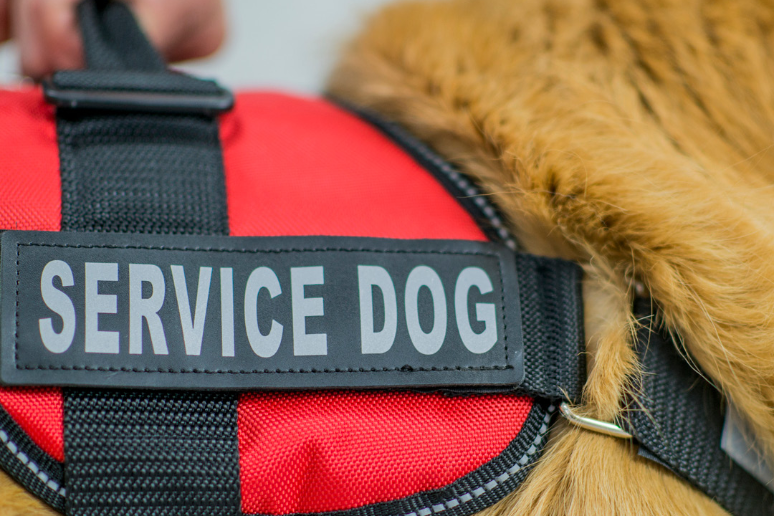There are important differences between service animals and emotional support animals you should be aware of. Your rights related to your animal may differ under the Americans for Disabilities Act (ADA), Fair Housing Act (FHA), the Air Career Access Act (ACAA), and other state and federal laws.
A service animal is specifically trained to perform a function necessary for a daily or medical need of a person with a disability. An emotional support animal is not specifically trained but is present to benefit the owner’s physical or mental health. In general, service animals are granted more rights under the law than emotional support animals.
Service Animals Under Title II and III of the ADA
The ADA defines a service animal as a dog that has been individually trained to perform tasks for a person with a disability. The task must be related to the person’s disability. Also, public entities have to make reasonable accommodations for the use of a miniature horse by a person with a disability if that horse has been trained to work or perform tasks for the owner’s benefit. Under Title II and III, emotional support animals are not service animals and do not get the same protections in public establishments.
“A service animal is one that performs specific tasks—usually physical in nature—that aid a disabled individual who is a customer, guest, patient, or patron to enjoy the goods and services of a public accommodation, such as a restaurant, retail store, hospital, museum, movie theater, etc.,” explained attorney James M. Paul, SHRM-SCP, a shareholder at Ogletree, Deakins, Nash, Smoak & Stewart, P.C.
Service animals can only be dogs or miniature horses. Examples of service animals are “a guide dog for the blind, a dog trained to sense the onset of a seizure for someone with epilepsy, or a miniature horse trained to pull someone using a wheelchair,” said attorney Greg Hurley, a partner in the Business Trial Practice Group at Sheppard Mullin. Mr. Hurley has litigated many issues under the ADA and FHA.
Proving Your Dog Is an ADA Service Animal
Though Titles II and III of the ADA protect service animals in public places, establishment owners do have the right to check that an animal is a service dog and not a pet.
Owners can ask two questions:
- Is this a service animal?
- What work or task has your animal been trained to perform?
Those are the only two questions an owner can ask. They can’t ask for documentation.
Owners also have the right to ask a person to remove their service animal from a public place if the animal is out of control, and the owner doesn’t effectively take action to control it, or the animal is not housebroken.
Animals Under Title I of the ADA
There are important differences in how animals are handled under Title I, II, and III of the ADA. Title I governs the relationship between employers and employees. “Title I of the ADA does not define service animal or emotional support animal at all,” said Mr. Paul. “Any type of animal potentially can be requested by an employee as a reasonable accommodation to assist them with performing their essential job functions.”
Because Title I does not define which animals might constitute a reasonable accommodation, “in theory, there are no restrictions on the type or species of animal that can potentially serve as a required accommodation, nor can emotional support animals be rejected automatically merely because they are not true service animals,” explained Mr. Paul.
Whether or not you can bring an animal that assists you to work depends on whether you can show it is necessary and reasonable accommodation under the ADA.
Assistance Animals Under the FHA
The U.S. Department of Housing and Urban Development and FHA use the term “assistance animals,” which is an animal that works, provides assistance, or performs tasks to benefit a person with a disability or an animal that provides emotional support that helps one or more effects of a person’s disability. This definition of assistance animal covers service animals and emotional support animals.
The benefit of having an assistance animal is that landlords have to make reasonable accommodations for the animal and cannot charge tenants a pet fee. Assistance animals are not pets, though. “A pet is usually an animal that merely provides companionship, keeps us company, entertains us, and/or provides protection or security,” said Mr. Paul. Assistance animals have a medical purpose.
“It’s very tough to distinguish emotional support animals from pets,” said Mr. Hurley. “When you think about it, what is the function of a pet other than to provide emotional support? The real distinction is being able to say, ‘I went to a doctor, and they were willing to say I needed this animal for my emotional support.’”
Proving You Have an Assistance Animal
Landlords have the right to ask for documentation regarding assistance animals. “There are a lot of misconceptions about this,” said Mr. Hurley. “But yes, landlords can ask to see some form of proof that there is a medical need for the animal. The big hot button issue is online certification, like CertaPet,” which allows a person to receive an emotional support animal letter through an online process for a fee.
Landlords often worry that the privileges associated with assistance animals are being abused. “The term licensed health care professional really gets stretched,” warned Mr. Hurley. “I’ve seen notes from massage therapists. Yes, they are licensed, but that is a different concept than a medical license.”
To make sure the intent of the law is respected, “landlords are increasingly saying they can’t accept certifications from businesses that are in the business of selling emotional support animal certifications,” according to Mr. Hurley. “Landlords require tenants to have an on-going relationship with the licensed health care professional who certified the animal.”
If you wish to have an emotional support animal that will not be challenged by a landlord, it is important to seek a certification letter from a trusted doctor or licensed mental health professional, such as a licensed professional counselor, psychologist, or psychiatrist.
Service and Emotional Support Animals Under the ACAA
Under the ACAA, service animals encompass animals that are individually trained or able to provide assistance to a person with a disability and animals that assist persons with disabilities by offering emotional support, according to the U.S. Department of Transportation (DOT).
Service animals are often allowed in the cabin of an airplane, though there are limitations on animals that are too large or heavy, those that cause significant disruption, or those that pose a health or safety threat to other passengers. Airlines do not have to allow snakes, reptiles, ferrets, rodents, sugar gliders, or spiders into the cabin.
Proving You Have a Service Animal to an Airline
Airlines can ask for documentation that is no more than one year and/or 48 hours notice for emotional support animals. The airlines can require documentation that shows you have a condition recognized by the Diagnostic and Statistical Manual of Mental Disorders, that you need your emotional support animal while you travel, that this assessment was provided by a licensed mental health professional and the passenger is under that professional’s care and the jurisdiction, date, and type of the professional’s license.
This could change. “The law is in a state of flux,” advised Mr. Hurley. “It is being driven by DOT and the pressure for dogs on airplanes. People are complaining to the DOT and FAA, and there is a new proposed rulemaking on restricting emotional support animals, which are allowed under the ACAA. This could drive changes with the FHA too.”
If the proposed rule is made into a federal regulation, then airlines could more strictly define service animals similar to the ADA and prohibit emotional support animals from the cabin.
 By Victoria Langley,
By Victoria Langley, 

